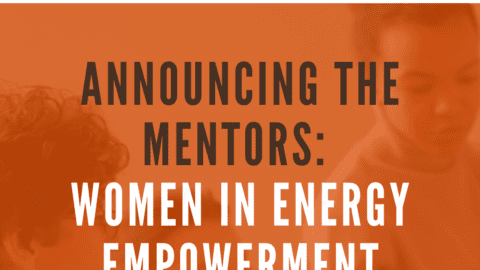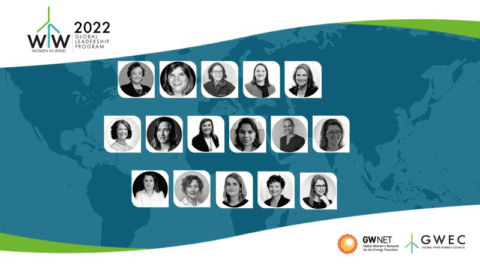By Irene-Giner Reichl, President, GWNET
One major effect of the global health crisis is to put governments (back) into the driver’s seat – for better or worse – in ways we have not seen in past crises. Governments impose lock-downs and adopt emergency programs. Nationals abroad are encouraged to rejoin their countries ASAP. Borders are closed and travel is disrupted.
This reflex of retreating to the perceived safety of the homeland – as risky as further disrupting globalization surely is – might linger on even after the virus has been tamed. A good thing to come from it would be renewed impetus to strengthen energy security through renewables and energy efficiency.
Renewable energy is available to all countries at all levels of development within their territories. Given the huge economic and social costs of lock-downs, post-pandemic national economies will be cash-stressed and will have to look for savings wherever they are achievable.
De-coupling to an extent from volatile global fossil fuel markets will become more attractive. And saving money by implementing energy efficiency measures more systematically will seem like a no-brainer. COVID-19 pushes electronic means of communication significantly. This gives an added urgency to resolving the access-to-electricity challenge. No home office without power and ICT.
Furthermore, people in lock-down everywhere have noticed the blue skies and the drop in air-pollution, the revival of nature in urban settings and reduction in noise.
As economies slowly re-start, citizens will be more prepared to appreciate the benefits of sustainable energy, provided the energy services can be delivered reliably and affordably.
So the moment must not be missed to give new impetus to the energy transitions that are under way in many countries, regions, cities and companies.
If renewable power additions decline in 2020 as a result of lock-downs and supply-chain disruptions, as anticipated by the IEA on 20 May, it is imperative that their growth resumes next year with added vigor.
Policies and strategies for energy transitions vary widely, but many have one thing in common – they are not gender-specific.
Currently, women do not participate on an equal footing with men in the energy sector [1]. While figures and methodologies vary, the most optimistic figures are that women only make up one-third of the sustainable energy labor force. When it comes to STEM or C-suite jobs, the percentages are much lower. Lack of attention to this disparity in energy transition policies and strategies risks perpetuating the male/female divide in sustainable energy.
This low participation of women in sustainable energy is a problem because it curtails women’s rights. It is a problem, furthermore, because it has been demonstrated [2] that female participation in corporate boards is good for the bottom line. Most importantly, however, energy transitions – and the deep societal transformations they entail – require the best available talent and the most diverse workforce possible to succeed. The current make-up of the workforce excludes valuable female viewpoints, experiences, and skills, and this is bad news.
The good news is that many actors in sustainable energy have recognized the benefits of greater diversity and use a wide variety of approaches and tools to redress the imbalances. GWNET’s recent study, “Women for Sustainable Energy: Fostering Women’s Talent for Transformational Change”[3] contains a good selection of these good practices.
The COVID-19 pandemic impacts women and men differently because women and men fulfil different societal roles. But also because the percentage of women working in informal settings and/or in part-time is much higher than that of women. Women also experience more economic uncertainty because of the persistent gender pay gap, even for work of equal value.
Workers on part-time or temporary contracts are less likely to benefit from social support schemes and unemployment benefits. These are also the jobs that are made redundant first.
For women entrepreneurs in sustainable energy, already before the pandemic, it was harder to access credit than it was for men; this situation is likely to worsen further as credit becomes very tight and at the same time paramount for the survival of firms.
Women do the lion-share of domestic chores; they are the primary care-givers and cooks for their families in all societies. “Tele-Working” and “home-schooling” sound like good solutions to a difficult health situation. It is necessary, however, to acknowledge that they significantly increase the unpaid care-work of women.
Consider for a moment the situation of a woman working from “home-office”, with her 3 school-age children and husband, also 24/7 at home, in their modest city apartment without a garden. Will it make it easier for her to prepare for her STEM qualification or to work on her next career move in her male-dominated energy company? It is a rhetorical question.
According to most recent IEA figures, overall global renewable power capacity will grow by 6% in 2020. Investment in renewables must be a key part of economic stimulus packages everywhere so that previous annual growth rates of renewables can resume or even increase. And women must be able to partake of and participate in the growth of renewables.
This is the time to make energy transition strategies – a cornerstone of all responsible stimulus packages and building-back-better strategies – inclusive for good. With all its terrible cost in terms of suffering and human lives lost as well as the economic recession and social stress, COVID-19 also opens avenues to make our societies more just and better fit for the future. Humanity cannot afford to miss this opportunity.
[1] IRENA, 2019, Renewable Energy: A Gender Perspective.
IEA & C3E International, 2019, Second Annual Status Report on Gender Equality in the Energy Sector.
[2] McKinsey & Company, 2007, Women Matter. Gender Diversity, a Corporate Performance Driver.
The World Bank, 2012, World Development Report 2012: Gender Equality and Development.
The World Economic Forum, 2020, Global Gender Gap Report 2020.
[3] https://www.globalwomennet.org/women-for-sustainable-energy/











